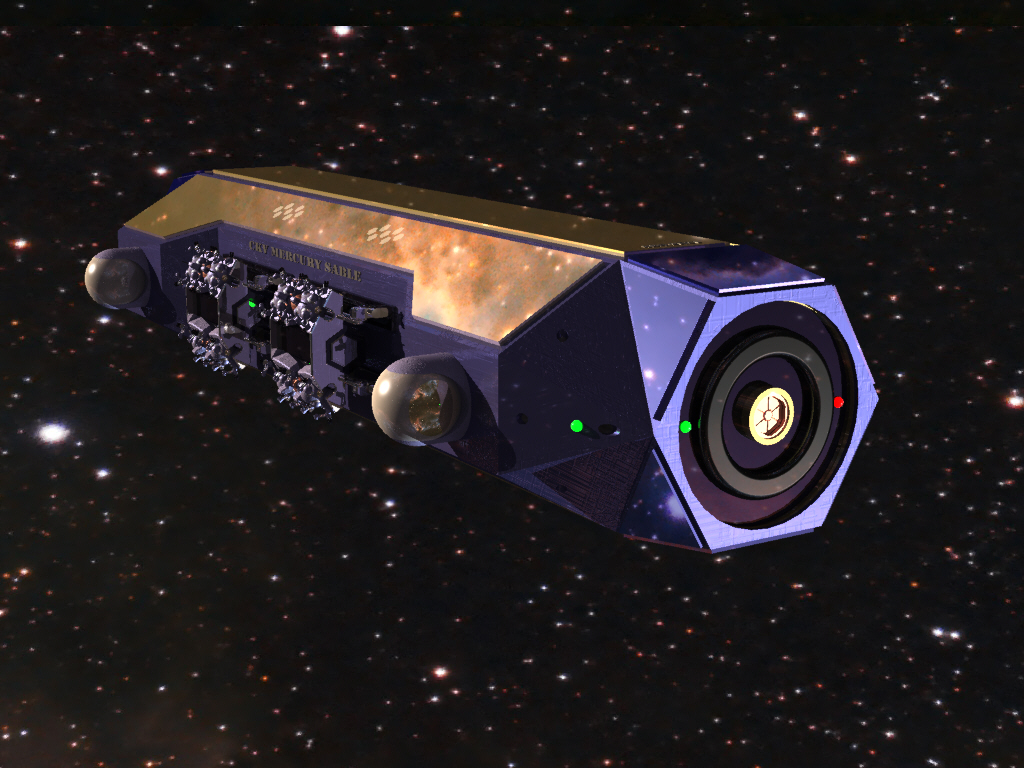RD-1 "Razorbill" Space Combat Drone
The RD-1 "Razorbill" is a class of space combat drone designed primarily for use by the Cobalt Knights spacer corps. Mid-sized, hardy, and versatile, the Razorbill has found use in every theatre of conflict the Cobalt Protectorate is involved with, including against Aniki Labs in the ongoing Armoa Conflict.
Power Generation
The Razorbill contains a set of supercapacitor batteries and a small radiothermal generator for its power needs. When not in operation, drones are typically held in charing racks to make sure they are ready to go on a moment's notice. A Razorbill can loiter indefinitely as long as its supply of radioisotopes is fresh, but, in practice, its combat endurance is measured in days due to the power requirements of its weaponry and sensor package.
Propulsion
The Razorbill possesses four powerful, insectile limbs tipped with four-fingered manipulators. In gravity wells or near the surface of other objects, these limbs can be used as legs for walking, climbing, and leaping. A common tactic is to launch Razorbills from one's vessel in a staggered pattern, commanding each to leap away from the craft using their legs. This saves a little fuel for the Razorbill while also imparting a reaction force on the launching vessel, which, in turn, moves the vessel away from its original trajectory, complicating the firing solutions of the enemy.
When operating independent of a surface, the Razorbill relies on a set of gimballed chemical thrusters for movement. The arms can be moved during thrust to provide additional steering or, during pivots, can be fully retracted to reduce the drone's moment of inertia. Stabilization and smaller movements come from internal reaction wheels. The Razorbill is not rated for atmospheric flight and has no control surfaces as such.
Weapons & Armament
The Razorbill comes armed with a single ultraviolet laser (a secondary function of its multispectral scope array) and a set of six cells for weaponry modules. These cells are most commonly filled with nuclear shaped charge missles tipped with bomb-pumped x-ray lasing media. Other options include additional lasers (with attached power supplies and lasing media if required), mass accelerators, electronic warfare modules, conventional missiles, and swarms of miniaturized reconnaisance drones.
When attached to an enemy vessel or installation, the Razorbill is capable of creating physical connections with electronic systems it finds to allow for hardware-based systems intrusion. The tool package mounted alongside each manipulator includes an optical camera (see Sensors), several common socket and screw drivers, and a set of guided electrical probes linked to the drone's limited machine intelligence. The remote operator or operators can use these tools to gain access to important systems and directly manipulate them instead of relying on open remote connections.
Armor and defense
The Razorbill is not heavily-armored, but its body is nevertheless capable of shrugging off some small arms fire, including from most personal laser weapons. The real durability of the Razorbill, like most Protectorate technology, comes from the multiple redundancy of its internal systems. A Razorbill can lose almost half of its mass and remain dangerous, though its maneuverability is most likely to be lost should it suffer such catastrophic damage.
Communication Tools & Systems
The Razorbill is meant to be piloted through a remote connection, and, as such, features a sensitive RF and laser communication suite with advanced integrated encryption. Razorbills are capable of operating independently should communications with the controller be cut; the drone's machine intelligence, while sub-sentient, allows it to continue to carry out its last recieved set of orders. Commands sent over direct line-of-sight laser communications are prioritized over all others because these are the least likely to be possibly spoofed by an enemy electronic warfare operation.
Sensors
In addition to its multispectral scope, the Razorbill is also equipped with radar, electromagnettic sensors, and gravity sensors. Additional cameras mounted along the manipulators allow the pilot to get a closer look at objects to which the drone adheres.
Additional & auxiliary systems
While it is most apt to call the Razorbill a combat drone, it has a limited ability to take on other roles due to the wide variety of modules which can be attached to it. Like all Protectorate assets, the Razorbill is expected to operate under diverse conditions possibly far removed from reinforcements or resupply. A generalist design, the Razorbill is outshone in certain specific mission profiles (i.e. close air support) by more purpose-built drones, but its reliability and flexibility make it a favorite among Cobalt Knight spacers deep in the field.
A shallow cargo bay along the belly of the Razorbill lets it fit additional equipment, which can be mounted to expansion slots along the overhead support trusses. Often, these slots are fitted with additional weaponry, sensors, or electronic countermeasures equipment. Importantly, anything mounted in this bay can, at the pilot's discretion, be jettisoned to provide enough space for one or two passengers. The hold isn't actively pressurized, but it does seal against the elements once closed; either passengers will have to provide their own breathing mix or the hold will have to be fitted with an inflatable membrane for this purpose. Older Razorbills are sometimes employed in search-and-rescue operations for this reason.
The CKV Mercury Sable carrying a complement of 16 Razorbills (four in each of four charging rack modules).
Class
Nickname
Razorbill
Designation
CKV RD-1
Manufacturer
Owning Organization
Rarity
Common
Related Technologies
Complement / Crew
0 (remote operation, limited automation)
Cargo & Passenger Capacity
1 (rescue)




Comments